[English] 日本語
 Yorodumi
Yorodumi- PDB-6v7r: Crystal structure of K37-acetylated SUMO1 in complex with PIAS-SIM2 -
+ Open data
Open data
- Basic information
Basic information
| Entry | Database: PDB / ID: 6v7r | |||||||||
|---|---|---|---|---|---|---|---|---|---|---|
| Title | Crystal structure of K37-acetylated SUMO1 in complex with PIAS-SIM2 | |||||||||
 Components Components |
| |||||||||
 Keywords Keywords | PEPTIDE BINDING PROTEIN / SUMO1 / PIAS / SUMO INTERACTION MOTIF | |||||||||
| Function / homology |  Function and homology information Function and homology informationnegative regulation of potassium ion transmembrane transporter activity / protein localization to nuclear pore / : / SUMOylation of nuclear envelope proteins / SUMO is proteolytically processed / Negative regulation of activity of TFAP2 (AP-2) family transcription factors / SUMO is conjugated to E1 (UBA2:SAE1) / negative regulation of delayed rectifier potassium channel activity / PML body organization / negative regulation of DNA binding ...negative regulation of potassium ion transmembrane transporter activity / protein localization to nuclear pore / : / SUMOylation of nuclear envelope proteins / SUMO is proteolytically processed / Negative regulation of activity of TFAP2 (AP-2) family transcription factors / SUMO is conjugated to E1 (UBA2:SAE1) / negative regulation of delayed rectifier potassium channel activity / PML body organization / negative regulation of DNA binding / SUMO is transferred from E1 to E2 (UBE2I, UBC9) / negative regulation of action potential / nuclear stress granule / small protein activating enzyme binding / SUMOylation of DNA methylation proteins / SUMOylation of immune response proteins / SUMOylation of SUMOylation proteins / XY body / regulation of calcium ion transmembrane transport / Maturation of nucleoprotein / SUMOylation of RNA binding proteins / regulation of cardiac muscle cell contraction / Postmitotic nuclear pore complex (NPC) reformation / Maturation of nucleoprotein / negative regulation of protein import into nucleus / SUMOylation of ubiquitinylation proteins / transcription factor binding / ubiquitin-specific protease binding / cellular response to cadmium ion / roof of mouth development / SUMOylation of transcription factors / ubiquitin-like protein ligase binding / SUMOylation of DNA replication proteins / protein sumoylation / potassium channel regulator activity / Regulation of IFNG signaling / postsynaptic cytosol / nuclear pore / transporter activator activity / negative regulation of DNA-binding transcription factor activity / SUMOylation of DNA damage response and repair proteins / presynaptic cytosol / Transcriptional and post-translational regulation of MITF-M expression and activity / SUMOylation of transcription cofactors / SUMOylation of chromatin organization proteins / positive regulation of protein-containing complex assembly / SUMOylation of intracellular receptors / PML body / PKR-mediated signaling / regulation of protein stability / Formation of Incision Complex in GG-NER / protein tag activity / positive regulation of proteasomal ubiquitin-dependent protein catabolic process / Recruitment and ATM-mediated phosphorylation of repair and signaling proteins at DNA double strand breaks / regulation of protein localization / cellular response to heat / nuclear membrane / protein stabilization / nuclear speck / nuclear body / DNA repair / negative regulation of DNA-templated transcription / ubiquitin protein ligase binding / nucleolus / glutamatergic synapse / enzyme binding / RNA binding / nucleoplasm / nucleus / plasma membrane / cytosol Similarity search - Function | |||||||||
| Biological species |  Homo sapiens (human) Homo sapiens (human) | |||||||||
| Method |  X-RAY DIFFRACTION / X-RAY DIFFRACTION /  SYNCHROTRON / SYNCHROTRON /  MOLECULAR REPLACEMENT / Resolution: 1.549 Å MOLECULAR REPLACEMENT / Resolution: 1.549 Å | |||||||||
 Authors Authors | Lussier-Price, M. / Wahba, H.M. / Mascle, X.H. / Cappadocia, L. / Sakaguchi, K. / Omichinski, J.G. | |||||||||
| Funding support |  Canada, 2items Canada, 2items
| |||||||||
 Citation Citation |  Journal: Structure / Year: 2020 Journal: Structure / Year: 2020Title: Characterization of a C-Terminal SUMO-Interacting Motif Present in Select PIAS-Family Proteins. Authors: Lussier-Price, M. / Mascle, X.H. / Cappadocia, L. / Kamada, R. / Sakaguchi, K. / Wahba, H.M. / Omichinski, J.G. | |||||||||
| History |
|
- Structure visualization
Structure visualization
| Structure viewer | Molecule:  Molmil Molmil Jmol/JSmol Jmol/JSmol |
|---|
- Downloads & links
Downloads & links
- Download
Download
| PDBx/mmCIF format |  6v7r.cif.gz 6v7r.cif.gz | 120 KB | Display |  PDBx/mmCIF format PDBx/mmCIF format |
|---|---|---|---|---|
| PDB format |  pdb6v7r.ent.gz pdb6v7r.ent.gz | 94.4 KB | Display |  PDB format PDB format |
| PDBx/mmJSON format |  6v7r.json.gz 6v7r.json.gz | Tree view |  PDBx/mmJSON format PDBx/mmJSON format | |
| Others |  Other downloads Other downloads |
-Validation report
| Summary document |  6v7r_validation.pdf.gz 6v7r_validation.pdf.gz | 437.1 KB | Display |  wwPDB validaton report wwPDB validaton report |
|---|---|---|---|---|
| Full document |  6v7r_full_validation.pdf.gz 6v7r_full_validation.pdf.gz | 437.3 KB | Display | |
| Data in XML |  6v7r_validation.xml.gz 6v7r_validation.xml.gz | 11 KB | Display | |
| Data in CIF |  6v7r_validation.cif.gz 6v7r_validation.cif.gz | 14.9 KB | Display | |
| Arichive directory |  https://data.pdbj.org/pub/pdb/validation_reports/v7/6v7r https://data.pdbj.org/pub/pdb/validation_reports/v7/6v7r ftp://data.pdbj.org/pub/pdb/validation_reports/v7/6v7r ftp://data.pdbj.org/pub/pdb/validation_reports/v7/6v7r | HTTPS FTP |
-Related structure data
| Related structure data |  6v7pC  6v7qC  6v7sC  6uyoS C: citing same article ( S: Starting model for refinement |
|---|---|
| Similar structure data |
- Links
Links
- Assembly
Assembly
| Deposited unit | 
| ||||||||
|---|---|---|---|---|---|---|---|---|---|
| 1 | 
| ||||||||
| 2 | 
| ||||||||
| Unit cell |
|
- Components
Components
| #1: Protein | Mass: 9567.801 Da / Num. of mol.: 2 Source method: isolated from a genetically manipulated source Source: (gene. exp.)  Homo sapiens (human) / Gene: SUMO1, SMT3C, SMT3H3, UBL1, OK/SW-cl.43 / Production host: Homo sapiens (human) / Gene: SUMO1, SMT3C, SMT3H3, UBL1, OK/SW-cl.43 / Production host:  #2: Protein/peptide | Mass: 1376.449 Da / Num. of mol.: 2 Source method: isolated from a genetically manipulated source Source: (gene. exp.)  Homo sapiens (human) / Production host: Homo sapiens (human) / Production host:  #3: Water | ChemComp-HOH / | Has ligand of interest | Y | Has protein modification | Y | |
|---|
-Experimental details
-Experiment
| Experiment | Method:  X-RAY DIFFRACTION / Number of used crystals: 1 X-RAY DIFFRACTION / Number of used crystals: 1 |
|---|
- Sample preparation
Sample preparation
| Crystal | Density Matthews: 2.01 Å3/Da / Density % sol: 38.95 % |
|---|---|
| Crystal grow | Temperature: 298 K / Method: vapor diffusion, hanging drop Details: 100 mM sodium cacodylate pH 6.5, 19 to 31 % (w/v) PEG3350 and 10 mM calcium chloride. |
-Data collection
| Diffraction | Mean temperature: 100 K / Serial crystal experiment: N |
|---|---|
| Diffraction source | Source:  SYNCHROTRON / Site: SYNCHROTRON / Site:  CHESS CHESS  / Beamline: F1 / Wavelength: 0.9775 Å / Beamline: F1 / Wavelength: 0.9775 Å |
| Detector | Type: DECTRIS PILATUS3 6M / Detector: PIXEL / Date: Mar 12, 2018 |
| Radiation | Protocol: SINGLE WAVELENGTH / Monochromatic (M) / Laue (L): M / Scattering type: x-ray |
| Radiation wavelength | Wavelength: 0.9775 Å / Relative weight: 1 |
| Reflection | Resolution: 1.549→30.263 Å / Num. obs: 24975 / % possible obs: 93.95 % / Redundancy: 5.7 % / CC1/2: 0.997 / Net I/σ(I): 12.23 |
| Reflection shell | Resolution: 1.549→1.604 Å / Num. unique obs: 1492 / CC1/2: 0.501 |
- Processing
Processing
| Software |
| |||||||||||||||||||||||||||||||||||||||||||||||||||||||||||||||||||||||||||||||||||||||||||||||||||||||||||||||||||||||||||||
|---|---|---|---|---|---|---|---|---|---|---|---|---|---|---|---|---|---|---|---|---|---|---|---|---|---|---|---|---|---|---|---|---|---|---|---|---|---|---|---|---|---|---|---|---|---|---|---|---|---|---|---|---|---|---|---|---|---|---|---|---|---|---|---|---|---|---|---|---|---|---|---|---|---|---|---|---|---|---|---|---|---|---|---|---|---|---|---|---|---|---|---|---|---|---|---|---|---|---|---|---|---|---|---|---|---|---|---|---|---|---|---|---|---|---|---|---|---|---|---|---|---|---|---|---|---|---|
| Refinement | Method to determine structure:  MOLECULAR REPLACEMENT MOLECULAR REPLACEMENTStarting model: 6UYO Resolution: 1.549→30.263 Å / SU ML: 0.22 / Cross valid method: THROUGHOUT / σ(F): 1.34 / Phase error: 25.1
| |||||||||||||||||||||||||||||||||||||||||||||||||||||||||||||||||||||||||||||||||||||||||||||||||||||||||||||||||||||||||||||
| Solvent computation | Shrinkage radii: 0.9 Å / VDW probe radii: 1.11 Å | |||||||||||||||||||||||||||||||||||||||||||||||||||||||||||||||||||||||||||||||||||||||||||||||||||||||||||||||||||||||||||||
| Displacement parameters | Biso max: 158.86 Å2 / Biso mean: 35.1703 Å2 / Biso min: 15.89 Å2 | |||||||||||||||||||||||||||||||||||||||||||||||||||||||||||||||||||||||||||||||||||||||||||||||||||||||||||||||||||||||||||||
| Refinement step | Cycle: final / Resolution: 1.549→30.263 Å
| |||||||||||||||||||||||||||||||||||||||||||||||||||||||||||||||||||||||||||||||||||||||||||||||||||||||||||||||||||||||||||||
| LS refinement shell | Refine-ID: X-RAY DIFFRACTION / Rfactor Rfree error: 0
| |||||||||||||||||||||||||||||||||||||||||||||||||||||||||||||||||||||||||||||||||||||||||||||||||||||||||||||||||||||||||||||
| Refinement TLS params. | Method: refined / Refine-ID: X-RAY DIFFRACTION
| |||||||||||||||||||||||||||||||||||||||||||||||||||||||||||||||||||||||||||||||||||||||||||||||||||||||||||||||||||||||||||||
| Refinement TLS group |
|
 Movie
Movie Controller
Controller



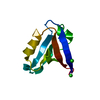
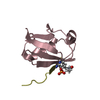

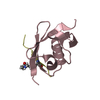

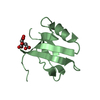
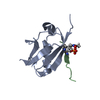


 PDBj
PDBj
















